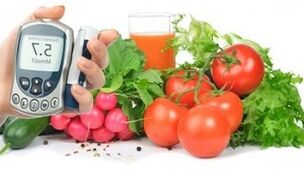
Diabetes is an endocrine system disease related to lack of insulin in the body.
As a result, the glucose content in the blood increases, which leads to metabolic disorders and gradually damages almost all functional systems in the human body. The disease is divided into type 1 and type 2 diabetes.Nowadays, nutrition and diet problems in any type of diabetes are a very serious topic, and every patient will raise this topic after being diagnosed with the disease.
Generally, proper nutrition for diabetes should be followed every day, because if you do not eat, your health will deteriorate.
The secret to lower blood sugar
Diet is essential for all types of diabetes, but dietary guidelines are different for type I and type II diabetes. In the latter case, reducing overweight in the diet may be the only treatment.
The type of diabetes is determined by the endocrinologist who treated you.
- In Type 1 Diabetes: Proper nutrition is a necessary background for insulin therapy. If you are not careful, all efforts to lower blood sugar are in vain: this indicator is unstable and affects the vascular state of all organs and systems.
- Type 2 diabetes: Medications are not always needed. First, advise the patient to eat to help lose weight. In this case, if the kinetics are good, the drug may not be needed at all.
General tips to help lower blood sugar:
- Reduce the consumption of soft drinks, lemonade and juice. Regular consumption of sweetened beverages increases the risk of diabetes by about 15%. When drinking tea and coffee, reduce the amount of cream and sweeteners.
- Try to choose unsweetened foods, such as unsweetened iced tea, yogurt or unsweetened oatmeal. You can add food according to your preference. Most likely, you will add much less sugar to the food than the manufacturer.
- Replace your favorite candies with healthier foods. Instead of ice cream, crush frozen bananas and stir the mixture with a blender to make a beautiful dessert. Instead of your favorite milk chocolate, it is best to eat a piece of dark chocolate.
Following eating habits is especially important for mild diabetes, because it is actually the main treatment.
Dietary differences between type 1 and type 2 diabetes

For patients with type 1 diabetes, a low-calorie diet (25 to 30 calories per 1 kg of body weight) is required to prevent later complications of the disease. In this case, diet is extremely important and must be strictly followed. The main thing to look for when composing a diet is the balance of protein, fat and carbohydrates.
Patients with type 2 diabetes need to receive a low-calorie diet (the daily energy value of food is 1600-1800 kcal). With this diet, patients should lose about 300-400 grams of body weight per week. In the case of overweight, the daily calorie intake will be reduced to 15-17 kcal per 1 kg according to the percentage of overweight.
Nutritional basis
In each case, the doctor will prescribe a special diet for diabetic patients, which must be adhered to to maintain normal health.
When you start eating well, follow these simple rules every day:
- You must eat food in small portions (every 2 to 3 hours) 5-6 times during the day.
- The ratio of protein, carbohydrate and fat should be balanced.
- The number of calories from food should be equal to the patient's energy expenditure.
Foods for diabetic patients should be rich in vitamins, so it is useful to include vitamin carriers in the diet: baking yeast, brewer's yeast, rosehip soup, SPP and dietary supplements.
Daily nutrition rules for diabetes
Diabetics can eat the following foods:
- Bread-up to 20 grams per day, mostly black or special diabetes.
- Use vegetable broth to cook soup every week, using weak meat and fish soup 1-2 times is allowed.
- Meat and poultry. For diabetes, you can eat boiled beef, chicken and rabbit meat.
- Vegetables and herbs. It is recommended to consume no more than 200 grams of potatoes, beets, and carrots per day. But other vegetables (cabbage, lettuce, radish, cucumber, zucchini, tomatoes) and green vegetables (except spicy) can be raw, boiled, and occasionally roasted almost unlimitedly.
- Cereals, beans and pasta should not be consumed regularly. If you decide to eat a plate of pasta, refuse bread and other carbohydrate foods and dishes that day.
- The daily consumption of eggs should not exceed 2 and add them to other dishes (boiled, boiled or omelet).
- Fruits and berries of sour and sweet and sour varieties (Antonovka apples, oranges, lemons, cranberries, red currants. . . )-up to 200-300 grams per day.
- Milk-approved by a doctor, kefir, yogurt (only 1-2 cups per day), natural or curd, cheesecake and pudding form cheese (50-200 grams per day).
- It is recommended to consume cheese every day, in natural form or in the form of cheese, cheesecake, pudding, casseroles, and consume 100-200 grams a day. Cheese, as well as oatmeal and buckwheat porridge, bran, rose hips can improve fat metabolism, normalize liver function, and prevent liver fat changes.
- Tea with milk, weak coffee, tomato juice, fruit and berry juice (total liquid contains soup, up to 5 cups per day).

Plan your menu carefully every day and use only healthy foods that suit your situation.
Prohibited products
The diet of diabetic patients should be considered. First of all, people diagnosed with this disease should refuse such products:
- Candies, chocolates, candies, baked goods, jams, honey, ice cream and other sweets;
- Spicy, salty, smoky snacks and dishes, lamb and pork fat;
- Pepper, mustard sauce;
- Alcoholic beverages;
- Grapes, bananas, raisins;
- Only a small amount of sugar is allowed without the permission of the doctor.
All diabetic foods should be eaten as planned, and in order to control blood sugar, the daily menu should contain fiber.
Sample menu of the day
When following the type 2 diabetes diet, you can stick to a simple menu and alternate between allowed foods.
Example #1
- Breakfast-oatmeal, eggs. bread. coffee.
- Snacks-natural yogurt with berries.
- Lunch-vegetable soup, chicken breast and salad (beetroot, onion and olive oil) and stewed cabbage. bread. fruit dish.
- Afternoon snack-low-fat cheese. tea.
- Dinner-Hake grilled with sour cream, vegetable salad (cucumber, tomatoes, herbs or any other seasonal vegetables) and vegetable oil. bread. cocoa.
- The second dinner (a few hours before bedtime)-natural yogurt, baked apples.
Example #2
- Breakfast: 150 grams of cheese, 150 grams of buckwheat or oatmeal, brown bread, unsweetened tea.
- Second breakfast: 250ml of unsweetened preserves.
- Lunch: 250 grams of chicken soup, 75 grams of boiled lean meat, 100 grams of cabbage stew, 100 grams of no candy jelly, bread, 250 ml of mineral water.
- Afternoon snack-1 apple
- Dinner: 150 grams of stewed vegetables, 100 grams of meatballs, 200 grams of cabbage cutlets, bread, unsweetened rosehip broth.
- The second dinner: drink yogurt-250 ml.
Example #3
- Breakfast: carrot and apple salad-100 grams, low-fat cheese and milk-150 grams of wheat bran bread-50 grams of sugar-free tea-1 cup. Second breakfast: 1 cup of mineral water, apples.
- Lunch: Soy vegetable soup-200 grams, beef stew-150 grams, caviar-50 grams of rye bread-50 grams of xylitol tea-1 cup.
- Afternoon snack: fruit salad-100 grams, sugar-free tea-1 cup.
- Dinner: fish cutlet-150 grams, millet milk porridge-150 grams of bran bread-50 grams of sugar-free tea-1 cup. The second dinner: Kefir-1 cup.
Remember:Diabetics should not be hungry. You should eat at the same time, but if there is a slight hunger between two main meals, be sure to silence it with a cup of tea or vegetables. But this should be just a light snack-overeating is dangerous for diabetics.































